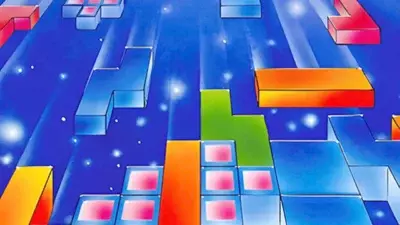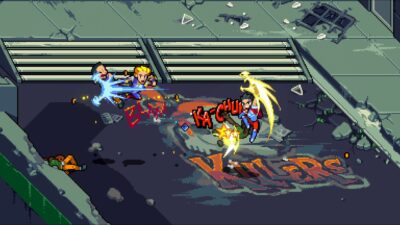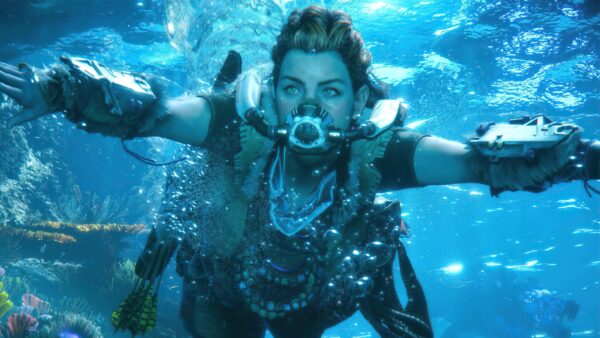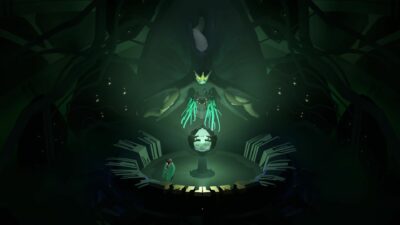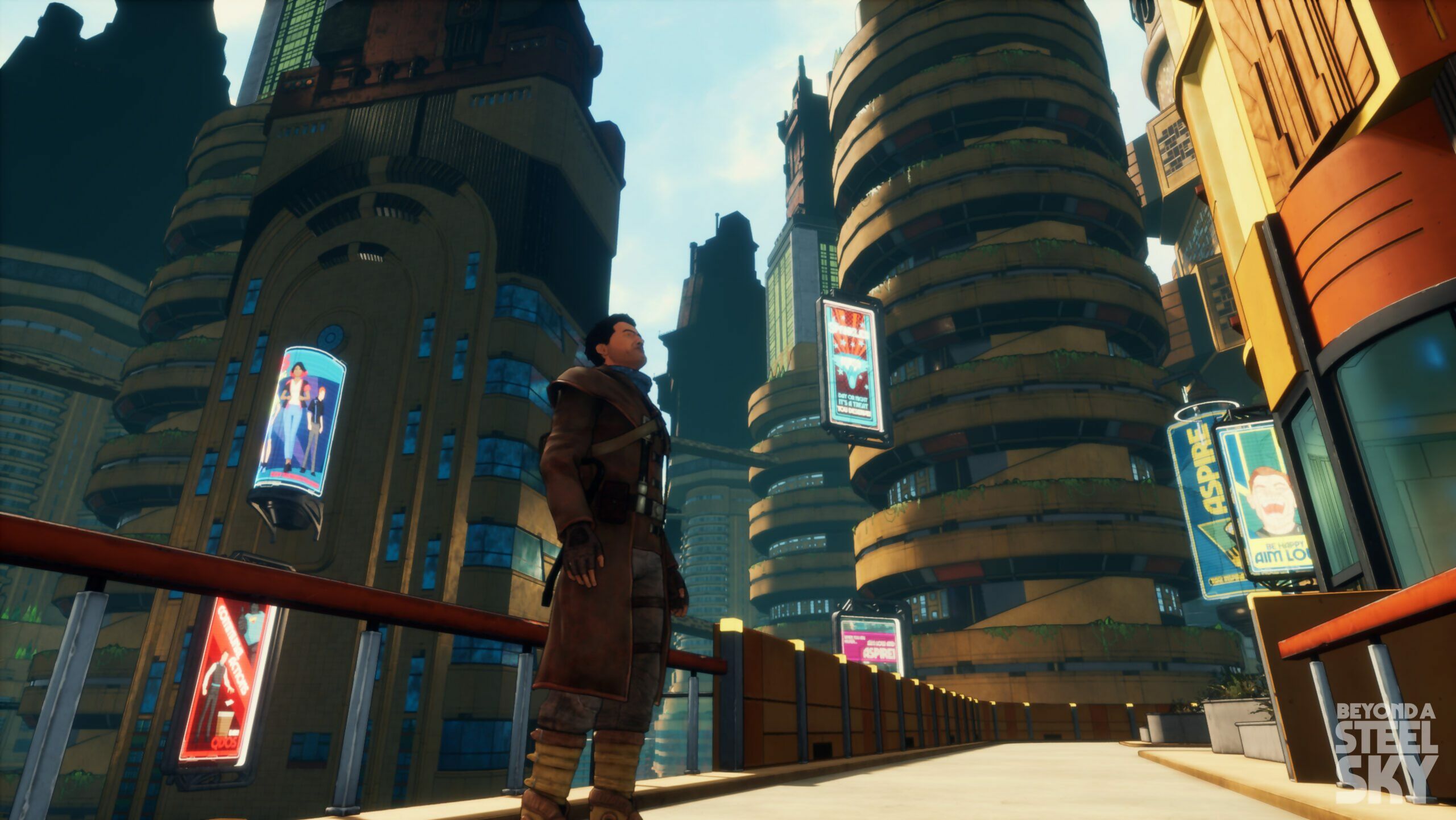
Surrounded by desert, Union City was the dystopian metropolis where Revolution Software based its classic adventure, Beneath a Steel Sky (BASS 1). Here, the rich lived at the bottom of vast spires, and the poor on their polluted tops. Digital entity LINC regulated all activity. It was an Orwellian nightmare, an inverted take on Fritz Lang’s Metropolis, and a setting that’s about to return in full 3D for its sequel, Beyond A Steel Sky (BASS 2).
To discover what went into the construction of the original Union City and its forthcoming successor, I asked Charles Cecil, co-founder of Revolution and designer of the Broken Sword series, comic artist Dave Gibbons of 2000 AD and Watchmen fame, and experienced 3D artist and graphic designer Sucha Singh, to lift the lid off the creative process.
A STEEL SKY
What predominantly set BASS 1 apart from its contemporaries, besides the unique artwork and design, was that the typical dystopian notion of the poor living below the rich was turned on its head. According to Gibbons, this was one of the things that attracted him to the project. “What you would expect,” he says, “is the kind of high-rise where the rich live on top, and all the horrible stuff happens at the bottom, but it makes equal sense the way we have it, too.” All the industrial pollutants located at the top of the city’s spires flow into the atmosphere, keeping the rich shaded and clean beneath the smog layer.

Evocative, mood-setting concept art is vital for creating an imaginary city.
In Union City, says Gibbons, “the cool, science fiction utopia-looking part was in the bottom third, then in the middle was where aspirational people lived in buildings a bit more rooted in our reality, and finally, above that, was the rusty, industrial area.” What Gibbons had to do was make each separate level distinct, while also making it a convincingly human habitat surrounded by the Australian desert. And though Union City was always situated on top of Sydney, Cecil admits they were “trying to hide [that] it was in Australia.” BASS 1 even featured a purposefully confusing subway station called St. James – a station found both in London and Sydney, despite Cecil remembering that “what Gibbons drew in the introductory comic were clearly kangaroos bouncing around.”
The Union City in BASS 2 seems less shy regarding its location, but aims to be true to the original. Time has passed, and now, according to Cecil, the city has moved away from being an outright dystopia. “What we wanted to do”, he says, “was to convey the same city but from a utopian perspective – actually take pre-existing assets and interpret what they would look like ten years later.”

An early block-out of Union City captures the geometry of the initial concepts.
Besides, Gibbons adds, “the whole dystopia thing has been greatly overdone in popular fiction and, particularly, in science fiction.” Even before the current crisis, he was convinced that people wanted a more positive, more colourful kind of entertainment not unlike Marvel’s movies. But, says Gibbons, ”just because a place looks like a utopia, doesn’t necessarily mean it is a utopia.”
Then there’s the city’s change from 2D to 3D. “A player can now look up and down,” Singh explains. “They can see and feel the sheer scale of it. The whole game is about contrast. Not just between characters but also within the city itself. We’re contrasting the outside to the inside, the three separate levels to each other, even the way locations are lit.”
VISUALS
According to Cecil, BASS 1’s visuals were created by having an artist take Dave Gibbons’ scanned pencil views then just paint over them. “We created a unique look, employed an innovative technique, and the game was pitched as an interactive comic,” Cecil says. “With BASS 2, our objective was to create a game that felt like any frame could have been drawn by a comic book artist.”
“We only explored the city to a limited amount in the first game, so it was good to get another bite of it,” Gibbons says. “I’ve always found I do some of my most creative work when there are limitations. The limitation here was what we established in BASS 1. We wanted to get the continuity right. What I did was to start with pencil sketches just as we did in BASS 1. This time though, instead of having someone paint over them, it was a question of refining the sketches by sending them back and forth between me and Charles and the guys at Revolution.”

Architectural concepts, details, and styles from all three levels of the metropolis.
Once at Revolution, Gibbons’ art was then turned into 3D models. “It’s really exciting when you’ve done something that is quite rough, going for a feeling rather than detail, and then seeing these figments of the imagination come alive in fully rendered, textured 3D,” Gibbons says.
As for the comic-book feel and the studio’s sophisticated toon renderer, Gibbons notes they achieved a “sort of linear quality. That effect you get in a conventional comic with a dark outline and colour within it, which gives the whole thing a really interesting texture.”
Singh, meanwhile, adds some technical details: “We came up with a method of rendering outlines in real time, and picking out the details of models and normal maps.” The outlines can fade or become thinner as they go into the distance, and can also be lit.

One of Dave Gibbons’ countless pencil sketches of Union City.
The city’s visuals are also influenced by architecture, which retains many of the first game’s elements. “There’s plenty of links to the past,” Singh says. “When I was looking at how we can translate what Gibbons did on BASS 1, and to address creating a utopian-looking city, I was looking at what period in history had a utopian emphasis, and I looked at the 1920s, when Art Deco came in.”
The style employs geometric shapes which fit the city’s three-tiered structure. “Along the lower level,” says Singh, “you have the curvy organic shapes, the mid-levels become more squared with rounded corners, and the upper levels remain inspired from the Brutalism of the sixties and seventies. Art Deco is the glue that holds the three different levels together, permeating and linking them architecturally.”

Concept art for the city’s main means of transportation: the monorail pod.
THE BUILDING
Cecil reveals that when it comes to size, the 3D Union City is, “about the size of York; several miles across, and not very big due to technical constraints.” Besides, this city isn’t spreading out horizontally; it’s spreading out vertically. Though not a typical open world, BASS 2‘s space is continuous, and players will be able to see across landmarks and game locations, getting a sense of the overall geography. They will, however, only be travelling to specific locations via monorail pods. “These pods whizz you around like the glass elevator in Charlie and the Chocolate Factory,” says Singh. “Nobody travels by train or car.”
Before the city’s overall design was approached, Singh says, the team came up with key gameplay locations. “And once those were defined and positioned, we started building the city to support them. A lot of thought went into infrastructure, traffic, and how people live or get their food.”
Cleverly, as Singh describes, “a lot is handled by the city itself.” There’s a food dispenser inside each apartment, and everything is happening behind the scenes, so that imaginary people and actual designers have less to worry about. Similarly, Singh explains, “we don’t have power lines as such; everything is kind of hidden away, and we have a lot of droids doing most of the grunt work.” The higher you go, the rougher these droids become; the lower you go, the more advanced they are. “As for the screens you see in the mid to lower levels, they are all holographic,” says Singh, whereas, “the more advanced the technology gets as we descend the spires, the greener the urban environment.”

A top-down view of Union City. Note the connections between the city’s spires.
The overall city building, Singh says, was “an iterative process; we started with a block-out based on Dave’s sketches, refined that, and then went to the concept artist who developed these further and in detail.” The detailed sketches were then used to refine the block-out even more, which also helped Singh establish the sense of scale. “You need to make it feel really tall, really big, and even the size of details like windows mattered,” he says. Interestingly, no perspective tricks were used; Gibbons argues that “you can tell when things have a real dimension to them, and your sense of space isn’t violated by optical illusions.”
Putting everything together was a huge task which Singh approached with a modular method. Each tower is made from sections (see Figure 1), “so we could swap the middle section for a different one, the upper section for another one, and so on. This way, we could build multiple towers from several component parts, and make them look not too similar to each other.”

Figure 1: A modular system was used to create the varied towers of Beyond a Steel Sky.
ADDING CHARACTER
The characters that populate Union City are also key to both games. Gibbons and the team did “hundreds and hundreds of sketches to come up with compelling characters who not only acted in interesting and quirky ways, but looked like real individuals. All the secondary characters got as much thought into them as the principal ones, and it all adds to the feeling that this place really exists.” As Cecil adds, “The characters belong to those locations, because we’ve designed the characters to fit the narrative and the locations to fit the characters.”
Seeing the almost finished city, Gibbons is “amazed by how coherently everything hangs together.” Cecil, besides appreciating the coherence and immersion the city offers, also talks about its “drama, claustrophobia, and vertigo,” while Singh is delighted with “the fact that we’re able to build a large city in the time we’ve had. It looks convincing. It looks good.”


